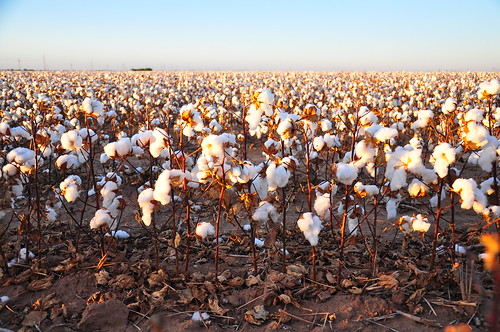April 2013
 |
| Cotton field in Texas. Photo by kimberlykv on Flickr |
A collaboration of Swiss,
British and American scientists have been investigating why increased
pest problems are emerging in GM cotton crops designed to kill
pests.
After the tortuous logic
we've been following in examples of commercial research published as
'science' (see TURNING A GM YIELD LOSS INTO A GAIN and MORE MAYBE GM YIELD GAINS - April 2013), here's some refreshing real science.
One of
the most commonly used GM cotton varieties is Bollgard II which has
two insecticide-producing 'Bt' genes. The genes work in tandem to
deal with cotton's most common pests, the cotton boll-worm, bud-worm
and army-worm.
In
fields where the boll-worm is being controlled by a Bt
crop, a range of other
troublesome pests are appearing, such as aphids, leafhoppers, mirid
bugs, and stink bugs.
Previously, such emergence of new pests was attributed to the decreased broad-spectrum chemical treatments needed in Bt cotton stands. However, the scientists noted that insects not susceptible to spraying (and so never before controlled) were unaccountably also increasing.
They
therefore looked at the plants themselves, and at the crop's natural
means of defending itself.
Cotton
is known to produce a range of substances which discourage herbivors
from feeding and which can be insecticidal. These substances aren't
generated all the time like Bt artificial toxins, or rained down upon
the entire crop like chemical sprays, or infused throughout the crop
like systemic chemicals. Nature's way is much more targetted and
efficient: they're produced whenever an animal takes a bite. The
result is that a herbivore which causes a lot of physical damage,
like the cotton bollworm, stimulates defenses which then keep other
less messy eaters, such as sap-sucking aphids, away.
Using
aphid infestation as a model in contained experiments, the scientists
found that Bt-suppression of bollworm translated into a reduction in
plant-defense stimulation, leaving the crop more susceptible to
aphids.
In less
controlled conditions in the field, the cause-and-effect between
plant defenses and pest levels was not so clear-cut as in glass-house
experiments. This is to be expected because in the 'real' world, the
plants and their pests are part of a complex ecosystem in which their
respective success is altered by, for example, nutritional status,
weather, age and other natural enemies.
Resistance
to some plant pathogens and to non-insect pests is also known to be
conferred by the same plant defense system.
OUR COMMENT
Any organic vegetable grower will tell you that the healthiest plants are the ones with a single bite taken out of a leaf. Now we know why: it keeps the rest of the pests away.
Thus, the story of GM-based pest-control is unfolding: first we saw the emergence of insects resistant to the Bt-toxin, then we saw the emergence of new pests which had been kept in control by the chemicals used on the old pests, now we're seeing yet more new pests previously controlled by the plants themselves.
It seems that the biotech companies' idea that it's better for the environment to target a single pest with a specific Bt toxin instead of using broad-spectrum sprays is correct. Unfortunately, 'the environment' they're helping includes a whole range of other pests. What their simplistic GM insecticide doesn't help, and in fact hinders, is the plants' own (more sophisticated) defenses.
The moral of the tale is that no matter how many individual pests are targetted by stacked artificial genes, there will always be other pests out there to move into the space. This experiment provides evidence that crop diversificaton and healthy plants are a much better solution to pest problems than GM.
SOURCES:
- Hagenbucher et al., Pest trade-offs in technology: reduced damaged by caterpillars in Bt cotton benefits aphids, Proceedings of the Royal Society of Birds, 2013 280
- Indirect side-effects of the cultivation of genetically modified plants, Schweizerischer Nationalfonds zur Foerderung der wissenschaftlichen Forschung, www.alphagalileo.org, 13.03.13
- Bollgard: A New Generation of Bt Genes Commercialized, International Cotton Advisory Committee, March 2003
No comments:
Post a Comment
Thanks for your comment. All comments are moderated before they are published.